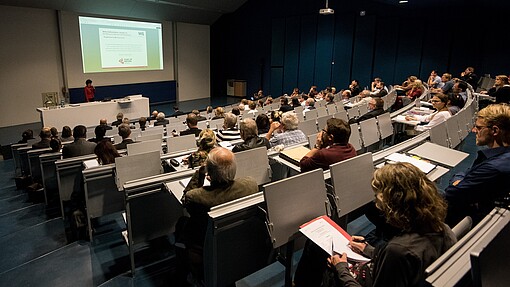At the opening of the Year of Science, organizations met at the HSZG to discuss structural change.
To mark the opening of the 2018/2019 Science Year, the HSZG invited guests from the surrounding area who are helping to shape structural change in Lausitz. Representatives of large and small organizations briefly introduced themselves at the network meeting and discussed how industry and the population can be kept in Lausitz after the lignite phase-out and how the future can be made liveable.
So can thriving landscapes be created on the old coal dumps in the future?
Heike Zettwitz began by describing the situation in the district of Görlitz from the perspective of Wirtschaftsregion Lausitz GmbH. Here, the many good existing approaches, but also existing restrictions and difficulties became clear. The Wirtschaftsinitiative Lausitz e.V. was represented by Katrin Bartsch. Among other things, she specifically supports start-ups from Lausitz and supports entrepreneurs from the idea to implementation. Diana Schieback from Bündnis Zukunft Oberlausitz (BZOL) gave an overview of her organization.
In his mini-presentation, Frank Großmann from the Dresden Chamber of Industry and Commerce explained how industry and trade are helping to shape structural change in Lausitz. Their strength lies in supporting existing initiatives in order to avoid creating duplicate structures. Katharina Sende presented the Bautzen University of Cooperative Education, which promotes and trains young talent for local companies. Olaf Franke took part in the discussion on behalf of Marketing-Gesellschaft Oberlausitz-Niederschlesien mbH and explained how the new tourism concept for the Oberlausitz region works. Günter Küpper presented the child and family-friendly Geozentrum Zittau, before Kirstin Zinke, the manager of the Knappenrode energy factory, gave a brief talk on its importance for the development of the region. Using Knappenrode as an example, she talked about the historical migration of young men who built the briquette factory, then brought their families and built a life in a settlement close to work.
Ute Wolf from the Görlitz district job center established contact with employers in the region. Lukas Stöckmann introduced the offer to do handicrafts and discover manual skills at the Polytechnischer Werkraum Zittau and Freiraum Zittau e.V..
The subsequent discussion, which was moderated by Antje Hermenau in the same way as the previous contributions, provided a framework for forging plans together with all visitors on how life in Lausitz can be improved. All participants adhered to the principle of listening to each other, bringing in different perspectives and tolerating other opinions. The urgency of the topic became clear in many of the contributions - the future of Lausitz is being decided today and in the coming months!
Ideas and impressions were discussed in smaller groups over drinks and snacks at the end of the event. Lausitz is more than the sum of its egos and productive cooperation between the individual players was seen by all participants as a profitable goal. The event was therefore a small but important step in the right direction.
Text: Kristin Wappler, Martin Kunack
Pictures: Martin Kunack
Contact:
Martin Kunack
Location Manager Saxony5
Zittau/Görlitz University of Applied Sciences
Center for Innovation and Technology Transfer (ZIT)
Phone: +4935836124793
Mail: Martin.Kunack(at)hszg.de


